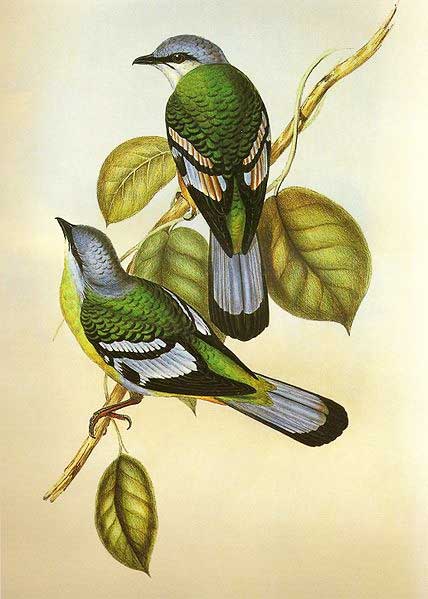
Cochoa viridis
Superregnum: Eukaryota
Cladus: Unikonta
Cladus: Opisthokonta
Cladus: Holozoa
Regnum: Animalia
Subregnum: Eumetazoa
Cladus: Bilateria
Cladus: Nephrozoa
Superphylum: Deuterostomia
Phylum: Chordata
Subphylum: Vertebrata
Infraphylum: Gnathostomata
Megaclassis: Osteichthyes
Cladus: Sarcopterygii
Cladus: Rhipidistia
Cladus: Tetrapodomorpha
Cladus: Eotetrapodiformes
Cladus: Elpistostegalia
Superclassis: Tetrapoda
Cladus: Reptiliomorpha
Cladus: Amniota
Classis: Reptilia
Cladus: Eureptilia
Cladus: Romeriida
Subclassis: Diapsida
Cladus: Sauria
Infraclassis: Archosauromorpha
Cladus: Crurotarsi
Divisio: Archosauria
Cladus: Avemetatarsalia
Cladus: Ornithodira
Subtaxon: Dinosauromorpha
Cladus: Dinosauriformes
Cladus: Dracohors
Cladus: Dinosauria
Ordo: Saurischia
Cladus: Eusaurischia
Subordo: Theropoda
Cladus: Neotheropoda
Cladus: Averostra
Cladus: Tetanurae
Cladus: Avetheropoda
Cladus: Coelurosauria
Cladus: Tyrannoraptora
Cladus: Maniraptoromorpha
Cladus: Maniraptoriformes
Cladus: Maniraptora
Cladus: Pennaraptora
Cladus: Paraves
Cladus: Eumaniraptora
Cladus: Avialae
Infraclassis: Aves
Cladus: Euavialae
Cladus: Avebrevicauda
Cladus: Pygostylia
Cladus: Ornithothoraces
Cladus: Ornithuromorpha
Cladus: Carinatae
Parvclassis: Neornithes
Cohors: Neognathae
Cladus: Neoaves
Cladus: Telluraves
Cladus: Australaves
Ordo: Passeriformes
Subordo: Passeri
Infraordo: Passerida
Superfamilia: Muscicapoidea
Familia: Turdidae
Genus: Cochoa
Species: Cochoa purpurea
Name
Cochoa purpurea Hodgson, 1836
Vernacular names
References
The Journal of the Asiatic Society of Bengal 5 p. 359
The green cochoa (Cochoa viridis) is a bird species that was variously placed with the thrushes of family Turdidae or the related Muscicapidae (Old World flycatchers). It is considered closer to the former.[2]
Description
Lithograph by Gould, female above
This Himalayan thrush is moss green. The male has a blue crown, blue wings and tail with a broad black band on the tail. The female has a more greenish body with some rusty spots on the wing coverts. The secondaries and tertiaries have the base of the outer webs yellowish brown with very narrow blue edging, unlike in the male. In some plumages there is a white collar on the sides of the neck.[3][4] This form was once described as a new species Cochoa rothschildi.[5] First year birds have dark shaft streaks on the body feathers.[6]
A female green cochoa; note the characteristic rufous tinge on the wing panels
Distribution and habitat
The green cochoa is found in Cambodia, China, India, Laos, Myanmar, Nepal, Thailand, Vietnam, and possibly Bhutan. Its natural habitats are subtropical or tropical moist lowland forests and subtropical or tropical moist montane forests. They make seasonal movements that are not well understood. Their distribution in winter in India is unclear as the species is found only in summer. An old record from Uttaranchal (Nainital) is the westernmost record, and no recent records exist from Nepal. Most records are east of northwest Bengal.[3]
Behaviour and ecology
Egg
The green cochoa is usually seen in pairs or small groups sitting in tall trees. They usually feed close to the ground, on mollusks, insects and berries. They sometimes launch aerial sallies to capture insects.[6] This species breeds in summer, and the nest is much like that of the purple cochoa, but is usually placed close to water. Both parents take turns incubating. The song is a thin and clear feeeee that dies away. Calls include a short high-pitched pok and harsh notes.[3][6]
The glossy eggs are ellipsoidal and densely speckled.[7]
References
BirdLife International (2016). "Cochoa viridis". IUCN Red List of Threatened Species. 2016: e.T22710147A94236945. doi:10.2305/IUCN.UK.2016-3.RLTS.T22710147A94236945.en. Retrieved 11 November 2021.
Sangster, G; Per Alström; Emma Forsmark; Urban Olsson (2010). "Multi-locus phylogenetic analysis of Old World chats and flycatchers reveals extensive paraphyly at family, subfamily and genus level (Aves: Muscicapidae)" (PDF). Molecular Phylogenetics and Evolution. 57 (1): 380–392. doi:10.1016/j.ympev.2010.07.008. PMID 20656044.
Rasmussen, PC; JC Anderton (2005). Birds of South Asia. The Ripley Guide. Volume 2. Smithsonian Institution and Lynx Edicions. p. 372.
Oates, EW (1890). Fauna of British India. Birds. Volume 2. London: Taylor and Francis. pp. 160–161.
Delacour, Jean (1942). "The Whistling Thrushes (Genus Myiophoneus)" (PDF). The Auk. 59 (2): 246–264. doi:10.2307/4079555. JSTOR 4079555.
Ali S; SD Ripley (1998). Handbook of the birds of India and Pakistan. Volume 9 (2nd ed.). Oxford University Press. pp. 19–20.
Oates, EW (1905). Catalogue of the collection of birds' eggs in the British Museum. Volume 4. London: British Museum. p. 92.
Retrieved from "http://en.wikipedia.org/"
All text is available under the terms of the GNU Free Documentation License

